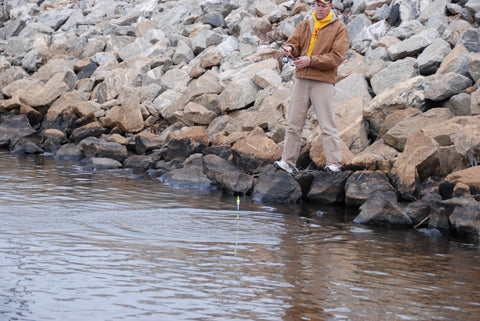
How To Catch Winter Spillway Crappie
How To Catch Winter Spillway Crappie
By Phillip Gentry
Because tailrace waters behind the majority of man-made impoundments are rich with baitfish, game fish, particularly crappie are abundant there as well. When water temperatures drop below the 50-degree mark, baitfish dispersed all over the upper river areas instinctively move up current. Despite colder water temperatures, baitfish work their way upriver and are effectively corralled into compact masses.
As water temps begin to fall even more, baitfish become disoriented by the cold water. Hungry predators, especially schools of crappie, lie in wait in slack water areas and feed on the disoriented bait.
“The rock outcroppings along the edges of spillways behind any major man-made impoundment create eddies close to the bank” said B’n’M pro staffer Kent Driscoll, “those are great hiding places for crappie to lie in wait and ambush bait that is swept along by the current.”

Man-made spillways provide current and highly oxygenated water, which attract both baitfish and hungry crappie.
Driscoll indicates that since cold water and dissolved oxygen are evenly distributed throughout the spillway area, crappie are just as likely to be found along the bank in 3 feet of water as they are in deep holes out in the middle of the run. He also pays attention to prevailing weather conditions to help pin down the whereabouts of spillway crappie.
“On a cloudy day, the crappie in the spillway seem to prefer the deeper haunts out in the center of the run” he said. “However, on a sunny, bluebird day, I have often found them just below the surface of the water hanging around flotsam and debris that collects in an eddy or other slack water area along the sides of the spillway run. Those are the days when you can ease along the bank and cover a lot of ground fishing anything that looks good. Because the current dictates the movement of the fish, by the time you work your way all the way around the immediate spillway area, you can often find fish back in the same spots you’ve already caught fish from.”
Unlike many crappie fishing venues, spillway fishing offers good access to both boating and shore bound anglers. By virtue of their design, spillways allow bank fishing anglers to get closer to the fish than boating anglers have in circumstances where regulations may limit how close boats are allowed to the spillway.

Outcroppings along the edge of the spillway provide current breaks and crappie love to hide behind these to ambush prey.
Because of restrictions established by Homeland Security measures, boaters must remain a distance of 200 yards from the structure. That’s 200 yards of crappie-rich environment accessible only on foot.
“Bank fishing anglers do well pitching double-rig jigs under a cork from the bank into the current” said Driscoll. “Because the water swirls and eddies, it provides action to the jigs as they bounce along under the cork. There’s a lot of debris- rocks and rebar from the construction of the spillway as well as wood that has washed in and miles of fishing line strung between them. The cork suspends the jigs above all that structure where crappie lay up out of the current and feed on disoriented bait washing through the spillway.”
Without the use of electronic sonar that’s available to boating anglers, shore bound fishermen have learned to “read water” to interpret what lies beneath.
“A slack water area that holds a lot of little black water bugs indicates there’s a seam where moving water meets slack water,” said Driscoll. “Finding seams in the current is a key to catching crappie along the spillway. Drifting that cork along the seam will put the bait right in the fish’s face and that’s important in the winter because the cold water slows down a crappie’s metabolism and they won’t chase a bait down in January like they would in May when water temps are higher.”

Bank anglers can also get in the action by flipping a double crappie jig rig suspended under a slip cork.
Driscoll suggests using a 10-foot B’n’M Duck Commander Double Touch crappie rod with a slip float so anglers can adjust the depth of the jigs without having to re-rig. Below the cork he’ll thread a 1/16-ounce jighead on the line and then tie the second jig to the end of the line using a loop knot. The upper jig is then secured using another 2-to-3-inch loop knot a foot and a half above the bottom jig. The 10-foot rod is an ideal length to pitch the cork
“Crappie Magnets work well for casting and drifting through spillway runs,” said Driscoll. “The arms wave in the current as the slip float washes along over the structure.”
Also in Weekly Tips and Techniques

Winter Crappie Fishing Strategies with Lance Hughey
B’n’M pro-staffer Lance Hughey said it never gets too cold to catch crappie.

North Texas Fall Crappie Fishing with Brian Carter
Texas crappie pro-staffer Brian Carter loves to pitch jigs at standing timber during the fall of the year.

Summer Crappie Fishing with Billy Blakley
B’n’M pro-staffer Billy Blakley claims the copious amount of rainfall so far this year has created some great summer crappie fishing on Reelfoot Lake.
